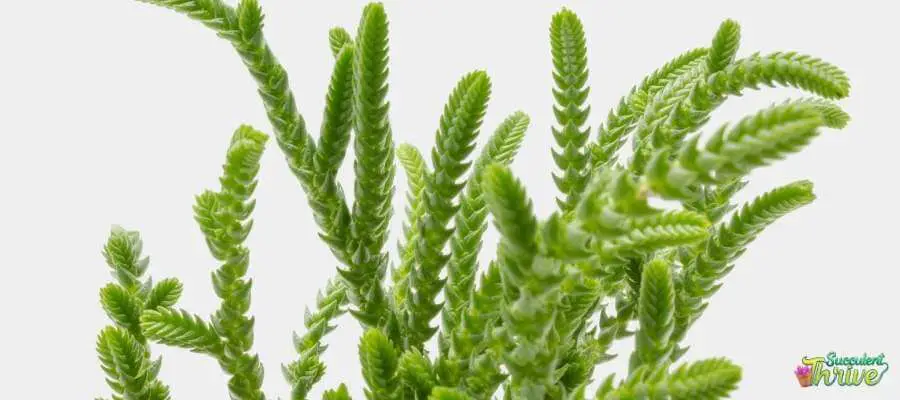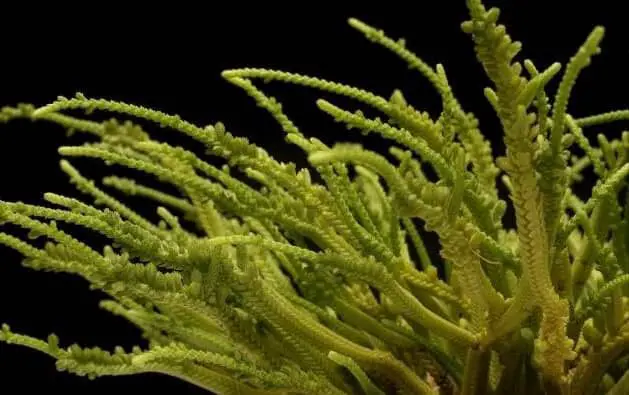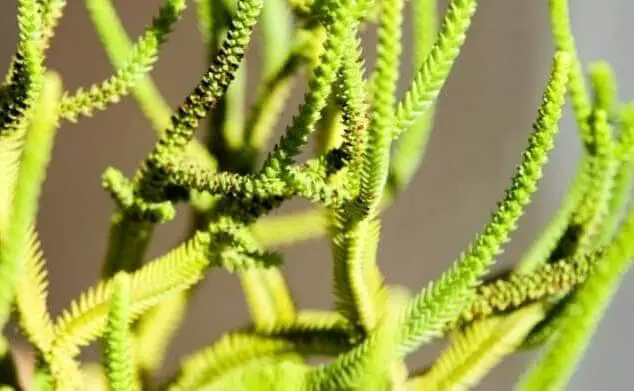Watch Chain succulent is a plant that grows up vertically with little green leaves. This plant is also called a zipper plant because of its unique shape. It grows as a bush and has a very interesting appearance. Watch chain succulents can be used as a filler when you create succulent pots because of this plant’s appearance. It is a beautiful inclusion to any collection of succulents. They grow very long. It could grow really fast in the growing period. so let’s see how to care for Watch chain succulent.
How do I identify a Watch Chain Succulent?
It has thick, glossy, smooth leaves that fill in contradicting sets along the branches on the watch chain succulent. Leaves are rich jade green, albeit some may give off an impression of being to a greater extent a yellow-green.
It may grow a red shade on the borders of the leaves of the plant when exposed to undeniable degrees of sunlight. New stem development is similar tone and surface as the leaves, getting woody and earthy colored with age. It develops as an upstanding, adjusted, thick-stemmed, unequivocally expanded bush and arrives at height statures of up to 2.5 meters on watch chain plant. The base usually is scantily fanned.
Now and then, a solitary principal trunk of up to 6 centimeters in width is shaped. The succulent roots are dim green. The bark of more established branches strips off in level, caramel stripes.

| Condition | Answer |
|---|---|
| Common Name | Watch Chain Succulent |
| Botanical Name | Crassula muscosa |
| Plant Size | 3–12″ inches tall width of 8″ inches |
| Light Requirements | Morning sun, Bright Full sun |
| Soil Type | Fertile well-draining, dry soil |
| pH of Soil | Acidic, Neutral |
| Blooming | During spring to mid-summer |
| Flower Colors | Greenish-white flowers,Unlikely to bloom in Indoor |
| Growth Zone | USDA zones 9-11 |
| Native To | South Africa and Namibia |
| Toxicity | Toxic to cats and dogs,(in (ASPCA) list of plants that are toxic) |
| Average price | 5-10 USD |
| Other names | Crassula princess pine, Zipper Plant, Lizard’s tail succulent, Clubmoss Crassula, Rattail Crassula, |
Watch Chain Succulent other names
The most widely recognized of the regular names for this plant is Watch Chain for its fragile interlocking leaves that are similar to the tight goldsmiths’ connections that were utilized to append a pocket watch to the vest. It is likewise called Crassula Princess Pine, Clubmoss Crassula, Zipper Plant, Lizard’s tail succulent, and Rattail Crassula. The particular appellation “muscosa” is Latin for “overgrown,” concerning this current plant’s greenery-like looks.
It has also been called Crassula lycopodioides, which is regarding the plant resembling Lycopodium, a family of clubmoss
How do you take care of a watch chain Succulent?
Size
3–12 inches tall width of 8″ inches
Growth
Instructions to grow a watch chain succulent is similar to the procedure with Crassula plants. Keep them out in the morning so that they can get the light of the full morning sun when outside temperatures are at any rate 45 to 50 degrees F. (7-10 C.). Even on the hottest days of summer, some morning sun doesn’t appear too harsh for this plant yet is best joined with some sort of shade.
Light Requirements
Watch chain plant grows under the morning sun or in dappled sun, or even an incompletely obscure morning spot. Evade extended hours of sunlight time of the evening sun. Cutoff watering until the soil is totally dry; at that point, water altogether.
Temperature
Watch chain plant is an invading species and effortlessly proliferated from cuttings of the stem. On the off chance that the climate keeps a steady temperature of 68 to 70 °F (20 to 21 °C), with satisfactory moistness and brilliance, the cutting will, in this way, root and develop quickly.
Watering Requirement
Make sure to only water the plant if the soil feels parched when touched.
Soil Requirement
Watch chain crassula plant needs bright sun (full sun) to moderate shade or inside. It’s ideal to utilize the “splash and dry” technique and permit the soil to dry out totally between watering. Since Watch Chain isn’t cold strong, it ought to be brought inside when the temperature falls beneath 20°F (- 6.7°C)
Pot size
While picking a pot, ensure that it’s not very huge. An ideal alternative is a 4″ inch earth pot. Utilize a cactus soil mixture or a combination of half gardening soil and half perlite or pumice with great seepage.
Special Care Tips
Appropriate watering and lighting are the main indoor plant care segments, yet mugginess and temperatures likewise play a part. Try to attempt to impersonate the environment of the spot that the plant came from. If you keep watch chain succulent cold and wet it can lose roots and die off. So keep it in proper environmental condition for proper care
When you plant the watch chain succulents, you have to make sure that you get the piece of the succulent and keep it for 2 or 3 days before planting it for the ends to dry because the succulents hold a lot of water inside them. Also, the soil should have a lot of sand and a small amount of organic soil.
This is a beautiful and uncommon plant. Tiny leaves of the plant are growing firmly compact around the branch. If the watch chain is stretched, unhealthy, and getting brown, it is not a healthy watch chain. The plant may course whenever permitted to get cumbersome, which is likewise alluring in a presentation. On the off chance that you have an established example, just plant in quick depleting soil in a compartment with drain holes or in the ground.
Little, broken pieces of this succulent effectively grab hold in the soil to shape roots. Set up plants at times produce yellow blossoms. This plant fills toward the beginning of the day sun referenced above or in dappled sun, or even a part of the way obscure morning spot. Keep away from extended periods of time under the evening sun. Indeed, even in more relaxed, beachfront spots, the watch chain plant likes obscure evenings.
Retain from watering until the soil feels totally dry; when it does feel dry, water altogether. Plant Watch Chain Crassula in the correct spot, and it will develop and flourish for quite a long time to come.
How do you propagate a watch chain Succulent (crassula muscosa)?
propagation process is very easy
- Remove a stem from the primary plant.
- Let it dry for a few days.
- Place it on well-draining soil.
- Water when the soil feels completely dry.
How do you repot a watch chain succulent?
At the point when you plant the watch chain succulents, you need to ensure that you get the piece of the succulent and save it for 2 or 3 days for the ends to dry under the light because of the fact that the succulents hold part of water inside them. Additionally, the soil ought to have a lot of sand and a modest quantity of natural soil.
Is watch chain toxic to cats?
watch chain crassula muscosa isn’t initially from North America, South Africa, and parts of it are known to be poisonous to people and creatures, so be careful when planting it around kids and pets.
Are all Crassula plants toxic?
All pieces of the are viewed as toxic. While the substance liable for the poisonousness of the plant stays obscure, it is encouraged to get the pets far from the leaves, blossoms, stems, and foundations of the plant—Dodge contact with the sap or thistles.

Related questions
Is Crassula an indoor plant?
Depending on your environment, these plants can be either planted in your garden or planted inside. Outside, most types of Crassula like well-depleting soil; they will respond thoughtfully to boggy, wet soils, as their foundations can decay. Indoor pruned plants flourish in a well-depleting pot mixture planned for succulents.
How do you propagate a zipper plant?
This type of plant is intrusive and effectively engendered from stem cuttings. Place 3 to 5 stem cuttings in every pot and spot them under shelter. Water it with care until it begins to develop.
Is Crassula Muscosa toxic?
The Crassula Muscosa family is remembered for the American Society for the Prevention of Cruelty to Animals (ASPCA) rundown of plants that are poisonous to felines and canines.
Does Crassula need direct sunlight?
Most Crassula plants need some shade in the sultriest piece of summer however require brilliant light to accomplish their most energetic tone. At the point when developed outside, a site with morning sun and evening concealment is excellent.
Can Crassula plants be rooted in the water?
Yes, and it’s simple. Fill a glass with water and place the stem in it or stick it around an inch somewhere down in a sodden preparing blend. Take out leaves that are below the water or underneath the dirt. Likewise, it’s possible to engender a jade by putting the end part of the stem, its leaves, in preparing a blend or saturated sand.
Can you propagate a dead succulent?
Engendering is the final retreat in the event that your succulent cannot recover from its state. Cut a few enduring solid leaves from the stem and let the finishes dry for five to seven days. Place them on a plate or a shallow dish in a succulent soil blend. Water routinely for the roots to develop; however, ensure there is acceptable seepage.
Can you propagate Crassula?
Fortunately for you, the answer is yes, you can! Engendering from leaves is simple! Essentially pick a firm, solid leaf. Detach it from the fundamental plant by tenderly turning the leaf away from the plant’s stem. Be certain not to leave any of the leaves on the stem (on the off chance that you take a touch of the stem with the leaf, that is fine, as well!).

